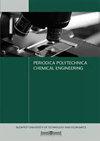Pyro-gasification of Rice Husk to Bio-fuel
IF 1.8
4区 工程技术
Q3 ENGINEERING, CHEMICAL
引用次数: 0
Abstract
Rice husk is a promising candidate of sustainable biomass-based renewable energy source with a gross caloric content of around 19.73 MJ/kg. As an efficient thermo-conversion process, pyro-gasification has the potential to convert biomass into oil and gas fuels. However, the bio-oil and gas yields are strongly dependent on the pyro-gasification operating parameters. This study employed response surface methodology (RSM) based on central composite design (CCD) experiment to determine the optimum conditions for pyro-gasification of rice-husk. Three selected most influencing operating parameters, namely feed mass (g), nitrogen flow (mL/min), and reactor temperature (°C) were optimized through 16 individual experimental runs for their possible synergistic effects. The results show excellent model fitting criteria (R2 > 0.9 and R2-adj > 0.85) for bio-oil and gas product responses that proves the suitability of RSM based on CCD experiment for rice-husk pyro-gasification study. The optimized optimum condition for rice-husk pyro-gasification process was at 897 g of feed mass, 1.97 mL/min of N2 gas flowrate, and 593 °C of reaction temperature. These conditions allow the achievement of estimated bio-oil and gas product yield of 47.78% and 11.41%, respectively. The composition analysis revealed that the main component of bio-oil was C15 (unsaturated), whereas the gas products were C3–C4 . This study suggests that rice-husk pyro-gasification is capable to achieve maximum yield of bio-oil and gas products with low char generation.稻壳热解气化制生物燃料研究
稻壳是一种很有前途的可持续生物质可再生能源,其总热量约为19.73 MJ/kg。作为一种高效的热转化过程,热解气化具有将生物质转化为石油和天然气燃料的潜力。然而,生物油气产量在很大程度上取决于热解气化操作参数。本研究采用基于中心复合设计(CCD)实验的响应面法(RSM)确定稻壳热解气化的最佳工艺条件。选取影响最大的三个操作参数,即进料质量(g)、氮气流量(mL/min)和反应器温度(°C),通过16个单独的实验来优化它们可能的协同效应。结果表明,生物油气产品响应的模型拟合标准R2 > 0.9, R2-adj > 0.85,证明了基于CCD实验的RSM对稻壳热解气化研究的适用性。稻壳热气化工艺的最佳工艺条件为897 g进料量,1.97 mL/min N2气体流量,反应温度593℃。在这些条件下,生物油气产率可分别达到47.78%和11.41%。组分分析表明,生物油主要成分为C15(不饱和),气产物为C3-C4。该研究表明,稻壳热解气化能够实现低炭产率的生物油气产品的最大产量。
本文章由计算机程序翻译,如有差异,请以英文原文为准。
求助全文
约1分钟内获得全文
求助全文
来源期刊

Periodica Polytechnica Chemical Engineering
ENGINEERING, CHEMICAL-
CiteScore
3.10
自引率
7.70%
发文量
44
审稿时长
>12 weeks
期刊介绍:
The main scope of the journal is to publish original research articles in the wide field of chemical engineering including environmental and bioengineering.
 求助内容:
求助内容: 应助结果提醒方式:
应助结果提醒方式:


